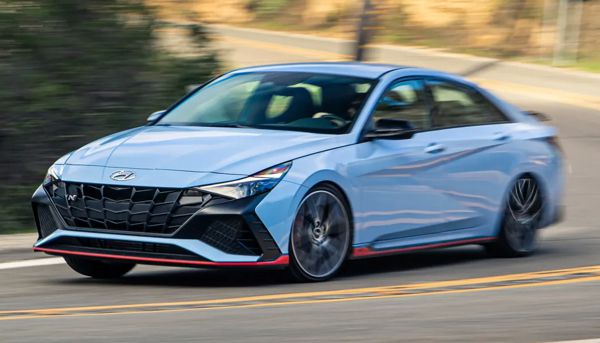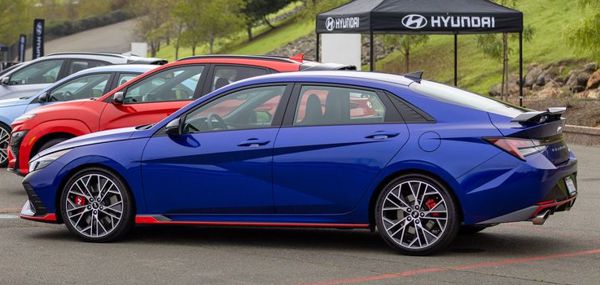Published
on 16
Sep 2021
|
All rights reserved.
|
|
|

|
|
Radical
look guises old engines and familiar dynamics.
|
|
Elantra (or Avante in
Korea) is one of the
biggest selling nameplates in the world, thanks mostly to the success
in China. However, in the USA, it consistently falls behind sales
leaders Honda Civic and Toyota Corolla, and by quite a margin. Last
year, the Japanese duo recorded 261,000 units and 237,000 units,
respectively, compared with 105,000 units of Elantra. Can the new
generation Elantra narrow that gap? We shall see.
The last generation Elantra had not much wrong. It was pretty
good-looking, spacious, economical to run and affordable. These
attributes are mostly carried over to the new car, but Hyundai works a
bit harder on the styling front and interior, hoping they could give
the new car a more distinctive character.
And what a character! Styled by the corporate design theme called
"Sensuous Sportiness", the new Hyundai Elantra looks unusual, or even
strange to some eyes. While the long and sleek profile might sound
modern, it looks like neither a hatchback nor a sedan (which it is). To
inject more character into the design, its stylists added many sharp
edges and crease lines to the body shell, including the 3 straight
crease lines that join at the front door. That’s probably overdone, and
they could make the car feel a bit flimsy. Some details are not very
well resolved, too, such as the cheap-looking black plastic that covers
the pseudo rear quarter window, and the massive front grille obviously
inspired by Braun shavers.
Compared with the outgoing car, it is 55mm longer and 20mm longer in
wheelbase, which is a class-leading 2720mm. No wonder US EPA classified
it as a mid-size car. Inside, it is spacious. Rear legroom is
especially generous, rivalling that of Civic. Despite a lower roofline,
headroom is still pretty good, especially up front. On the downside,
trunk space is just average.

|
|
The
instrument tries to look like MBUX...
|
|
While the last Elantra employed a conservative interior styling, the
new car is far more adventurous. Its “immersive cocoon” design seems to
learn from the outgoing Jaguar XJ, with a sleeker and lower mounted
dashboard. Meanwhile, a large grab handle forms a blade at the
transmission tunnel, pretending to be a Corvette. Of course, it cannot
escape from hard plastics, but on higher specification cars, many
places are covered with soft pseudo leather to feel suitably expensive.
The instrument looks a bit weird though. It tries hard to look like
Mercedes MBUX, covering both the digital instrument and infotainment
touchscreen under a single piece of glass. Unfortunately, the 8-inch
touchscreen in lower spec. models looks ill-fitted to the larger back
panel, while the instrument graphic is a bit cartoonish. Upgrading to
10.25-inch touchscreen looks better, but still the shapes of the screen
and the back panel don’t match, lacking the coherence in Mercedes.
Moreover, the blank gloss area left hand side of the instrument looks
strange. It is reserved for the drive mode selector of N line model. It
looks as if Hyundai’s engineers forgot to remove it from the mass
selling Elantra, and the afterthought is inserting a functionless
circle for decoration. We always praise the “form follows function”
philosophy of Volvo. Sometimes we might accept a bit compromises in
form for function, but we would definitely hate poor form that offers
no function. This is an example.
Having said that, the new infotainment system functions well, offering
quick response, crisped graphics and an intuitive interface.
 |
|
You
need N Line to feel some excitement, yet it is no Golf GTI.
|
|
Compare with European compacts, the engine choices here are few. Most
buyers
are limited to either the carried-over 2.0-liter Atkinson-cycle engine
with 147hp and mated to a CVT, or the 141hp 1.6-liter hybrid powertrain
transplanted straight from the aging Ioniq (not the new electric
ones!). Neither can raise your pulse, though offer acceptable
performance and decent economy. The cheaper car rides on a torsion-beam
rear axle, whereas the Hybrid is upgraded to a multi-link setup, but
just to make space for its battery. Anyway, both cars are major on
comfort rather than driving excitement. There is plenty of grip and
predictable handling, but they lack the control of Honda or Mazda.
Steering is predictably light and lifeless.
Upgrading to N Line is the only solution. Its 1.6 turbo motor is
carried over from the last generation Elantra Sport, generating 204
horsepower and should be good for 0-60 in 7 seconds, though it suffers
from a bit old-fashioned turbo lag. Transmission can be either 6-speed
manual or 7-speed twin-clutch. Its suspension is not only upgraded to
multi-link setup, but also gets springs that are 26% stiffer up front
and 71% stiffer in the rear, along with stiffer engine mounts and
larger front brakes. As a result, body control is much tighter. The
235/40R18 tires offer plenty of front-end grip, although lacking an LSD
means you need to be patient in tighter corners. Light and numb
steering remains its weakness. The N Line is undoubtedly a much more
capable car, but it is no rival to a Golf GTI. That task has to leave
to the upcoming Elantra N.
Surprisingly, despite the questionable tastes shown in exterior and
interior, the aging powertrains and unremarkable driving dynamics,
American motoring journalists still awarded it 2021 North American Car
of the Year. It proves that in the year of pandemic, journalists were
starved of new cars for too long. Or they might be too excited with the
Corvette grab handle.
|
Verdict:    |
Published on 6
Oct 2022
|
All rights reserved.
|
|
Elantra N
|
|

|
|
If
you can get over its looks, you will find a fun to drive performance
car.
|
|
Thanks to the leadership
of ex-BMW M division boss Albert Biermann, over the last few years
Hyundai's N performance brand has built a good reputation with cars
like i30N, Veloster N and i20N. The 4th member of the line is Elantra
N, whose target audiences are American motorists. While I don't think
it could rock the domination of Honda Civic Type R at the top of the
class, it offers similar level of performance for less money. In other
words, a performance bargain.
The Elantra N employs the same 2.0-liter turbocharged motor as the
i30N, rated at 280 horsepower and 289 lbft of torque, but it can be
overboosted to 290 hp for up to 20 seconds. Power drives the front
wheels via either a 6-speed manual or 8-speed DCT and an electronic
limited slip differential. It is good for 0-60 mph in about 5 seconds
flat and top speed is 155 mph, quicker than the likes of VW Golf GTI,
Seat Leon Cupra, Renault Megane RS or Ford Focus ST, if not the more
expensive and 4-wheel-drive camp of Golf R, Audi S3, BMW M135i or
Mercedes A35. At the price bracket of US$33-35K, this kind of
performance is virtually unbeatable.
The chassis is also up to the job. It rides on standard adaptive
dampers and oversized 245/35ZR19 Michelin Pilot Sport 4S rubbers. 360mm
front brake discs (315mm back) are employed to kill speed, while
chassis is reinforced by front and rear strut tower bars for 29 percent
higher torsional rigidity. Deeper chin spoiler, side skirts and a rear
spoiler complete the performance upgrade. The only downside is the
ungainly shape of the Elantra base car.

|
|
0-60
in 5.0 seconds is virtually unbeatable for this money.
|
|
If you can get over its looks, however, you will find a very competent
and fun to drive performance car. It is very fast, with plenty of power
and the engine doesn’t sound strained or feels flat like older Hyundai
engines. The new DCT works flawlessly, too, while 6-speed manual is
more fun to use, even though the latter still trails the best from
Honda or Mazda for feel. The car delivers good body control and
roadholding in spirited driving, while balance is decent. The active
LSD puts down power effectively, limiting understeer and wheelspin in
tighter corners without introducing torque steer. Give it some speed
and lift off mid-corner, the nose will tuck slightly into the apex if
you leave the stability control in its sportier modes. The steering,
while not totally transparent like so many front-drive modern hot
hatches, feels precise and reassuringly heavy. Turn-in is pretty quick,
maybe not quite as sharp as the shorter and more stiffly sprung i30N,
but in return you get a slightly smoother ride on the Elantra, not to
mention more room to spare for rear passengers. Up front, supportive
bucket seats hold you tight.
The Elantra might not stand out in any particular area, but the entire
package is very balanced and highly competitive. Just hope it could
look prettier.
|
Verdict:     |
|